Abstract
Unique vertical column structures were constructed for the greening of a structure at the Botanical Garden of Vilnius University, in which a plant cover was formed using the turf rolls of semi-natural meadows that were wrapped on 197 columns, with each column consisting of three equal segments. By evaluating the species composition and the abundance of vegetation in the segments of the columns, we studied how this natural cover changes and what its survival potential is. During the five years of observation, 97 plant species were determined in total. Over time, the initial plant species of fertile soils were mostly replaced by ruderal, nitrophilous, and pioneer plants. Out of the 58 original species, 18 disappeared, while 39 new ones emerged. In the vegetation cover on the north exposition of the building, the original species composition declined faster. The most persistent species were ruderal short-lived Conyza canadensis, Melilotus albus, and Urtica dioica, and long-lived Elytrigia repens. As for vegetation classes, the initial plant communities of the Molinio-Arrhenatheretea elatioris vegetation class were partially replaced by the plant communities of the Koelerio-Corynephoretea canescentis and Artemisietea vulgaris classes; however, unformed plant communities finally became prevalent. All directions, including the north, east, south and west, were equally dominated by semi-shade- and semi-light-loving plant species, together with a less abundant representation of light-loving species. Meanwhile, an unexpected establishment of the light-loving annual Arabidopsis arenosa was observed on the least illuminated north exposition. Likewise, the perennial Festuca pratensis, which is particularly resistant to wintering, emerged and spread on all expositions. The vegetation in the vertical columns was dynamic, and the initial plant species significantly diminished in the five years; however, as new species took place, the columns remained sufficiently covered with a green carpet of plants. This study reveals the benefits of using semi-natural meadow turfs in vertical greening of buildings in the harsh climate of a 5b hardiness zone, which is accompanied by distressing climatic fluctuations during the vegetation season.
1. Introduction
With the growth of urbanization, which is one of the most serious issues of the 21st century, the number of urban residents increases rapidly together with the demand for living space [1,2]. As a consequence of urbanization, the request for more green spaces in cities is arising [3]. One of the possibilities of expanding green areas is their integration into building structures. There are two main ways to adapt vegetation in green buildings: green roofs and green walls [4]. Green roofs and walls are sustainable building design elements that have gained attraction and are increasingly used in urban greening [5]. The use of green roofs is a fairly well-established practice worldwide, as flat spaces are easy to use and arrange. However, vertical greening of buildings has a greater impact on the built environment because the surface of a wall is larger than a roof area. It is estimated that the wall area of tall buildings can be as much as 20 times larger than the roof area. In addition, vertical greening improves the thermal properties of buildings [4,6], enhances air quality [1,7,8], increases energy efficiency, reduces noise, improves city aesthetics [3], and reduces stress caused by city life [9,10].
A green vertical system is a self-contained vertical garden attached to the external or internal walls of a building. There are two kinds of structures—“Green Facades” and “Living Walls” [1,4,11,12]. “Green Facades” use climbing plants and special supporting structures. Plants can be planted directly in the ground at the base of the structure or in pots at different levels of the walls [1,4]. Hanging plants and trees are used in the vertical planting of “Living Walls” [4]. This design of greening is particularly suitable for urban buildings, as it allows efficient use of the vertical surface areas [1,12,13]. It is also beneficial for installation in dry heat-affected areas since irrigating water evaporates less than on horizontal surfaces [1,13].
Various types of plants can be used for vertical greening of buildings: vegetables, climbing plants (ivies, roses, and vine grapes), mosses, lichens, alpine plants, and plants of natural flora [1,4,8,14,15]. The implementation of vertical greening systems in urban areas creates habitats for fauna and flora. The choice of plant materials is very important for the planning of greening architecture. Moreover, it is necessary to consider environmental conditions when choosing plant species [2,4]. The use of native plant species creates a landscape design that is harmonious with the nature of the region and is more economical, as native plants are better adapted to the local soil and climate and generally require less irrigation and fertilizer than non-native plants. Therefore, priority should be given to the group of plants that meets environmental conditions with minimal maintenance [16].
In constructing green buildings, obstacles are encountered when choosing plant species to create greater biodiversity together with harmonious aesthetic. In this context, there is a lack of studies that focused on the use of plant species from local flora. The purpose of our experiment was to use the turf rolls from semi-natural meadows in the original vertical columns installed for the greening of a building and to evaluate how such natural cover self-develops and what its sustainability potential is. The purpose of the five-year observation was to determine how the structure of the plant communities develops over time on different expositions (north, south, east, and west) and how the species diversity evolves and adapts while withstanding climatic fluctuations.
2. Results
2.1. Dynamics of Plant Species
During the five years of observation, 97 plant species were determined in total in the green column structure. Out of the 58 original species, 18 disappeared, while 39 new ones emerged (Table 1).

Table 1.
The presence (sp and Roman numerals), abundance, and coverage (Arabic numerals and symbols in the degree) of plant species in the vertical column segments by year and by the exposition of the columns.
Perennial plants dominated the plant cover of the vertical structures during the study. From the Poaceae family, the order of abundance was as follows: E. repens, Poa angustifolia, Poa pratensis, F. pratensis, and Dactylis glomerata (Table 1). From the Fabaceae family, the order was Vicia sepium, M. albus, Medicago falcata, Medicago lupulina, Trifolium repens, and Trifolium pratense. As could be expected, these species belong to forage plants, and they were installed in the columns with the turf from a semi-natural meadow. The newly occurring species were mostly ruderal plants, namely Chenopodium album, Concoluvulus arvensis, Crepis tectorum, Epilobium parviflorum, Euphorbia helioscopia, Fallopia convolvulus, Impatiens parviflora, Linaria vulgaris, Melilotus officinalis, Moehringia trinervia, Silene pratensis, Setaria pumila, Vicia hirsuta, and Viola arvensis (Table 1).
In each segment of all the expositions, the mean number of species in 2017 was significantly higher than in 2019 and 2021. The number of species in the segments on the north, east, and south expositions did not differ significantly between 2019 and 2021; meanwhile, the number of species in the segments of the west exposition differed significantly in all studied years. In 2017, the segments of the different expositions did not differ significantly by the number of species. The number of species in the northern segments in 2019 was significantly lower compared to the east and west expositions. In 2021, the segments on the north and east expositions differed significantly among themselves by the mean number of species and were characterized by the lowest and highest abundance of species, respectively (Table 2). The mean number of species stopped declining by the last year of observation on the east exposition, but a slight downward tendency remained in the segments on the north, south, and west expositions (Table 2). In all the expositions of the building, the number of species in the segments varied within very wide limits, and the increasing coefficients of variation over the years indicate this enduring tendency (Table 2).

Table 2.
Descriptive characteristics of the number of plant species in the investigated segments of the vertical columns, as well as a one-way analysis of variance (ANOVA) examining years and building expositions according to the number of plant species in the segments (CV—coefficient of variation (%); SD—standard deviation; df—degree of freedom; F—Fisher criterion; p—statistical significance; *—significant differences between years (p < 0.05); **—significant differences between expositions of the building (p < 0.05). Letters denote statistically significant (p < 0.05) differences: capital letters—between the years in each exposition, lower letters—between expositions each year).
During the five years of study, there was a clear shift in the composition of species in the columns, with some disappearing and others appearing. The most pronounced positive balance in the number of species was recorded in the segments on the east and west expositions, with values of +8 and +9, respectively (Table 3). An evident negative balance between extinct and newly emerging species was observed on the north exposition, with a value of −4. On the south exposition, the species balance was 0 and +1, suggesting that as many species disappeared in the segments as approximately the same number appeared (Table 3).

Table 3.
The shift in the number of plant species in the segments of the green columns according to the exposition of the columns.
2.2. Dynamics of Plant Communities
In the first year of the study (2017), more than two-thirds of the segments were covered by the plant communities that belonged to the Molinio-Arrhenatheretea elatioris R. Tx. 1937 phytocoenological vegetation class, i.e., the primary plant communities that were installed as the turf rolls into the vertical columns from a semi-natural meadow (Table 4 and Table 5). In the rest of the segments, unformed plant communities prevailed, except for one segment on the east exposition where the plant community belonged to the Nardetea strictae Rivas Goday et Borja Carbonell vegetation class. In 2019 (the third year of the study), more than ½ of all the segments remained predominately covered by the plant communities of the Molinio-Arrhenatheretea elatioris vegetation class. However, later on, the frequency of the plant communities belonging to the Molinio-Arrhenatheretea elatioris vegetation class rapidly decreased, and in 2021 (the fifth year of the study), the plant communities of this vegetation class came close to extinction (only identified in 1.7% of the segments). The assessment of the last year (2021) showed that unformed plant communities began to predominate in the vertical green columns, as these unformed plant communities were found in >60% of the segments (Table 4). In addition, at this time, the plant communities belonging to the Koelerio-Corynephoretea canescentis Klika et Novak 1941 and the Artemisietea vulgaris Lohm., Prsg et R.Tx. 1950 vegetation classes made up a considerable part of the green cover, occurring at 23.2% and 13.0% of the segments, respectively.

Table 4.
Distribution of plant vegetation classes in the segments of the vertical green columns in different years.

Table 5.
Structural description of the green columns.
Differences in vegetation development were observed depending on the column exposition (Figure 1). It was found that in 2017 and 2019, the south, east, and west expositions were predominated by the original plant communities of the Molinio-Arrhenatheretea elatioris vegetation class, but in 2021, almost all of them were replaced by unformed plant communities (Figure 1). A different situation was observed in the segments on the north exposition, where, already in the first year, the number of unformed plant communities exceeded the number of plant communities assigned to the Molinio-Arrhenatheretea elatioris vegetation class, and in 2019, this difference clearly shifted in favor of the former (Figure 1). In the last year of observation, the plant communities belonging to the Molinio-Arrhenatheretea elatioris vegetation class in the north side almost disappeared, while the communities of the Koelerio-Corynephoretea canescentis vegetation class and unformed plant communities were present to a similar extent in the segments (Figure 1). The plant communities of the Artemisietea vulgaris vegetation class were not recorded in the first year of the study. However, this type appeared in 2019 in one segment located on the east exposition. By 2021, communities of the Artemisietea vulgaris vegetation class were formed on all the expositions at a rate of 13% of the total segments (Figure 1, Table 4). Overall, the five years of observations showed that, in the vertical green columns, the initial plant communities belonging to the Molinio-Arrhenatheretea elatioris vegetation class declined and were largely replaced by unformed plant communities.
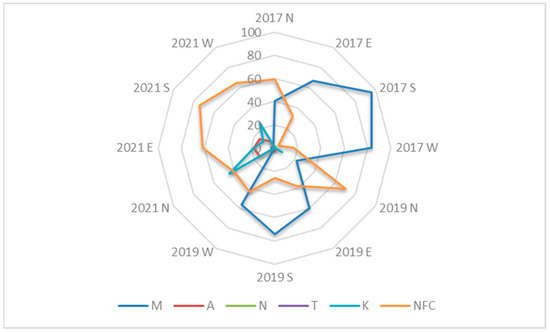
Figure 1.
Dynamics of plant vegetation classes in the segments of the vertical green columns in relation to the expositions of the building (north, east, west, and south) (M—Cl. Molinio-Arrhenatheretea elatioris; A—Cl. Artemisietea vulgaris; N—Cl. Nardetea strictae; T—Cl. Trifolio-Geranietea sanguinei; K—Cl. Koelerio-Corynephoretea canescentis; and NFC—unformed communities).
2.3. Light Requirement and Species Distribution
Based on the assumption that, in our green column construction, the greatest influence on the development of the plant cover should be sunlight radiation exposure, we divided the species according to their requirement for light using Ellenberg’s indicator values and assessed their distribution in the different expositions (Table 1, Figure 2). The majority of plant species belonged to the group of semi-shade-loving plants (61.2%), half as many were semi-light-loving plants (31.8%), and there were relatively few species of light-loving plants (7.0%) (Table 1). After evaluating the dynamics of the species, we found that semi-shade- and semi-light-loving species prevailed in all the expositions during the five-year period (Figure 2). During the last years, a slight increase in the number of light-loving plants was observed on account of a reduction in semi-shade- and semi-light-loving plants (Figure 2). Even though the overall balance of the number of species in the entire column system was positive (Table 3), the trend of species number decline was evident on the south and north exposition segments (Figure 2).
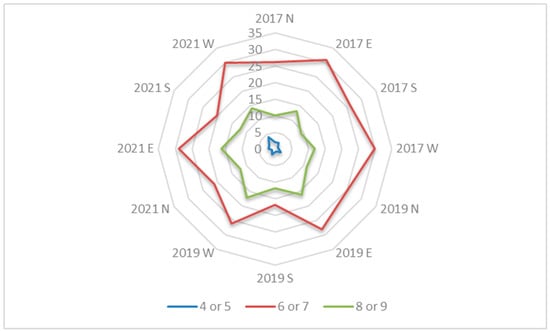
Figure 2.
Species assignment according to their light preference using Ellenberg’s indicator values and their distribution in the segments of the vertical green columns in different expositions (north, east, west, and south) in the study years 2017–2022. Ellenberg’s indicator values: 3—shade plants, mostly less than 5% illumination; 4—between 3 and 5; 5—semi-shade plants, rarely in full light, but generally with more than 10% relative illumination; 6—between 5 and 7; 7—plants generally in well-lit places, but also occurring in partial shade, and not found in less than 30% relative illumination; 8—light-loving plants found in relative illumination in summer no less than 40%; and 9—plants in full light, found mostly in full sun, and with illumination in summer no less than 50%.
We found that, over the course of five years, the initial composition of plant species from local semi-natural meadows declined; however, as new species actively took over, the columns remained sufficiently covered with green plant layers (Figure 3, Figure 4 and Figure 5). Our five-year assessment showed that the turfs installed in the vertical columns for a building’s greening allowed the plants to survive seasonal fluctuations characterized by sudden frosts in spring and frequent heat waves in summer (Figure 6, Table 6).
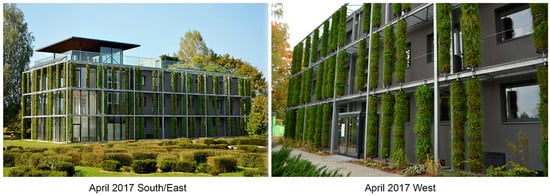
Figure 3.
The green columns during the first year’s spring season on the south/east and west expositions, April 2017.
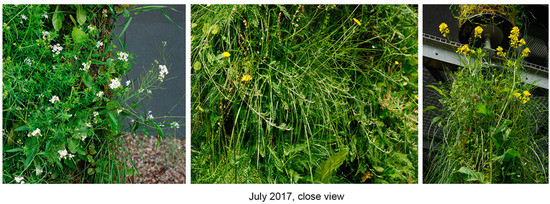
Figure 4.
An example of plant species representation in the green columns, July 2017.
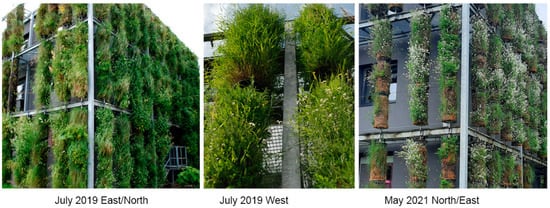
Figure 5.
The green columns during the third year’s summer season on the east/north and west expositions, July 2019; A. arenosa’s dominant representation in the fifth year’s spring season on the east/north exposition, May 2021.
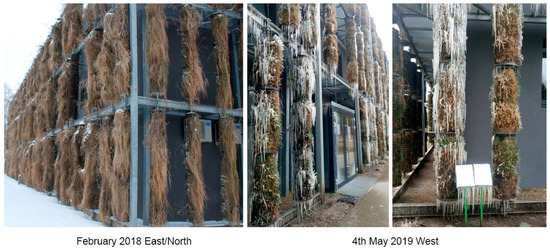
Figure 6.
Winter view of the green columns on the east/west exposition, February 2018; the damaging effect of a sudden frost in the green columns in the early spring season on the west exposition, 4 May 2019.

Table 6.
Overview of severe meteorological incidents in the study years 2017–2021.
3. Discussion
We installed a unique vertical column structure for the greening of a building at the Botanical Garden of Vilnius University. This green construction is unique because we used turf rolls cut from semi-natural meadows at the local site and wrapped them on 197 columns, each comprised of three equal segments. Our study allowed us to observe how the vegetation cover of semi-natural meadows changes in four different expositions of the building (north, south, east, and west). Ninety-seven plant species were recorded in the plant cover of the column segments during the five years of observation.
The columns we installed are unique not only due to the construction but also due to the meadow turf used. There is very little literature on a similar topic. Our study could be most comparable to the work of Stollberg and co-authors [18]. They used seed mixtures of natural meadow species in the construction of green walls and came up with a lot of useful technical experience. However, low seed germination (horizontal pre-growing stage) required a lot of re-sowing and resulted in uncovered gaps in the green layer, which was a disadvantage in terms of labor and time. Another group of researchers, Campiotti and coauthors [19], used a monospecies of Parthenocissus quinquefolia in building vertical greenery and analyzed the beneficial effect on reducing the heat temperatures in a Mediterranean region. Despite the fact that we did not measure such physical parameters, we assume that our green column structure significantly shaded the building and, thus, had an impact on its protection from the extreme heat in summer.
Regardless of the exposition, the initially dominant plant communities of the Molinio-Arrhenatherethea elatioris vegetation class were gradually replaced by unformed plant communities. In addition, the plant communities of the Koelerio-Corynephoretea canescentis, Artemisietea vulgaris, Nardetea strictae, and Trifolio-Geranietea sanguinei vegetation classes appeared in some segments of the green columns. In Central Europe, plant communities of the Molinio-Arrhenatherethea elatioris vegetation class are the most common [20]. Therefore, it is not surprising that this class of plant communities was initially detected as being the most abundant in the segments of the vertical structures formed by the turf of semi-natural meadows. Compared to others, plant communities belonging to the Molinio-Arrhenatherethea elatioris vegetation class are the most productive, comprising natural and semi-natural mesophyte communities that thrive in sufficiently moist and fertile soils. Meanwhile, communities of other vegetation classes occur in soils of different fertility levels characterized by different soil acidity, salinity, and moisture. Koelerio-Corynephoretea canescentis plant communities are common on seacoasts and continental sands with gravelly soils; Artemisietea vulgaris plant communities are established in areas with no humus soil layer; Nardetea strictae plant communities are formed in infertile, more acidic soils; and Trifolio-Geranietea sanguinei plant communities are found in warm and dry woodlands, forest sites, and meadow slopes [21,22,23,24].
In our study, the plant species in the green columns were disturbed when the meadow cover pieces were laid on these vertical structures. Thus, the plants were exposed and affected by a particular anthropogenic activity. Anthropogenic changes in the environment are known to promote the decline of species diversity [25]. As regards the species composition, Galium aparine, Stellaria media, E. repens, Achillea millefolium, P. angustifolia, P. pratensis, Rumex acetosa, T. pretense, and T. repens were found to be dominant in the vertical columns in the first year. Later, E. repens and A. millefolium remained dominant, even though their coverage in the segments decreased. The majority of the newly appearing species were ruderal plants, including Ch. album, Concoluvulus arvensis, C. tectorum, E. parviflorum, E. helioscopia, F. convolvulus, I. parviflora, L. vulgaris, M. officinalis, M. trinervia, S. pratensis, S. pumila, V. hirsuta, and V. arvensis, i.e., species that establish themselves in damaged or disturbed environments in open areas. It is likely that the seeds of these ruderal plants entered the columns with the composted soil that was used to fill the segments of the structure or from the seeds present in the initial turf layer, since ruderal plants are known to be the accompanying components in the vegetation of meadows [26].
M. albus, U. dioica, and C. canadensis were highly persistent during the experiment. Poaceae species also played an important role in green cover formation and development. This is likely due to their intensive colonization capability and persistence in ecosystems under different environments [27]. During the five-year study, the abundance of P. pratensis ceased, but F. pratensis spread prevalently; D. glomerata disappeared, while the coverage and abundance of E. repens increased. This could be the consequence of the original fast cover-forming species diminishing and leaving a free space for other species to establish themselves. T. Sasaki and W. K. Lauenroth [15] observed a similar trend in the plant communities of a shortgrass steppe. Their study showed that the loss of the dominant, rapidly cover-forming species might reduce the competition and alter the hierarchy of the dominant species in plant communities. It was shown that the removal of the dominant species Bouteloua gracilis from a long-term experimental site increased species diversity, the number of rare species, and the relative abundance of dominant species [15]. In another study conducted by Stollberg and co-authors [18], it was observed that species diversity increased after the disappearance of Stachys palustris, G. album, and Galium palustre. This corresponds to our observation that the loss of the initial dominant species in the vertical columns has led to the establishment and dominance of new species. Our results also correspond with the studies by Mårtensson and co-authors [28], and, thus, we can say that the vertical structure had a negative impact on the establishment of dominant species.
No threat in terms of the establishment of invasive plant species in the vertical columns was identified. Invasive Lupinus polyphyllus was recorded on all sides of the building in the first year of the study, and later, a single case of invasive I. parviflora species was observed. However, overall, it can be stated that the unnatural position of the meadow turf in the vertical structures prevented the establishment of invasive plants.
In our green column system, five plant species, Cerastium holosteoides, Mentha arvensis, Urtica urens, Sonchus oleraceus, and Tanacetum vulgare, were the most sensitive to the change from natural to vertical vegetation arrangement in the columns, as they disappeared already after the first two years. These species are found in nature close to cultivated fields, near homesteads, and on roadsides [29,30,31,32]. Perhaps, these species did not establish themselves in the altered habitat due to some climatic factors. This could possibly account for sudden frosts early in the season and/or severe heat during the summer. Temperature fluctuations and their extreme values are classified as the most important limiting factors for plant growth [28]. Generally, high temperatures have a negative impact on grassland species diversity [33]. In addition, the scale and frequency of extreme weather events are increasing, and so are climatic fluctuations, which affect changes in species diversity [34]. In addition, one of the negative factors could have been the absence of snow cover, and so the plants were more exposed to the cold in winter. Another reason could be the intra- and interspecific competition of plants for the availability of nutrients [35], as no fertilizers were applied in our system.
The obtained data were also analyzed based on the assumption that sunlight exposure was clearly a variable depending on the column exposition. The south exposition was the most illuminated. The east and west ones also had enough light, but on the north side, the plants grew in shade or semi-shade. Our observations showed that the different duration and intensities of light were likely to be the significant factors in the rearrangement of the species composition of the cover. Notably, on the north exposition, a faster loss of initial plant species and a greater establishment and dominance of nitrophilic and pioneer plants were observed than on other sides of the building. This shows that the most intensive changes in vegetation took place in the least illuminated vertical columns. As a result, this could be the reason why M. falcata and V. sepium disappeared on the north exposition, and the coverage of M. lupulina decreased. V. sepium frequency and coverage also decreased on the east and west expositions. Meanwhile, Ajuga reptans, which naturally grows in deciduous and mixed forests, woodlands, and forest slopes [32], decreased in number and coverage on all the expositions except on the north side.
Notably, we observed exceptional cases when some plant species successfully adapted and began to dominate in conditions that are not naturally characteristic of them. Light-loving A. arenosa plants (indicator value nine according to Ellenberg) appeared and established themselves in the segments on the north side, the least illuminated exposition. This is likely because of A. arenosa’s extraordinary ability in colonizing new places [36]. In contrast, in the columns of other expositions, the frequency and coverage of A. arenosa were lower, possibly due to the fast coverage effect of other rapidly growing species. M. Stollberg and coauthors [18] observed a similar trend, where the extinction of dominant species allowed other species to become established. Besides that, their study showed that light is not always the determining factor for plant dominance [18]. Therefore, in our study, when A. arenosa experienced less competition, shade was no longer a critical factor for this species to grow and complete its vegetation cycle. Meanwhile, the spread of F. pratensis in the columns can be explained by the high sustainability of this perennial grass in the 5b hardiness zone [37], which includes the south-eastern part of Lithuania where the Botanical Garden of Vilnius University is located [38].
4. Methods and Materials
4.1. Installation of Vertical Columns
The vertical structures were installed in August–September 2016 for the greening of the Administrative Laboratory building at the Botanical Garden of Vilnius University (Lithuania, Vilnius; N54.7362067, E25.4034823). Thirty-four columns were installed on the north, 75 on the east, 21 on the south, and 67 on the west exposition of the building (Figure 3, Table 5). Each column consisted of three segments (0.30 m in diameter and 0.90 m high) connected by a metal frame axis passing through a plastic hollow tube in the centre of the segments (Figure 7). The segment constructions were filled with composted soil, and turf rolls cut from the semi-natural meadows at the Botanical Garden were wrapped around the axis to make a plant cover. Fertile compost soil from the Botanical Garden was used. An agrotextile film was inserted between the compost soil and the meadow turf to retain moisture. The meadow turf was reinforced from the outside with a wire mesh. Each segment was covered with plastic covers at the top and bottom. An irrigation system was installed inside the columns. A plastic pipe was attached along the entire upper line of the column’s construction, from which four capillaries were inserted into each segment. Water was supplied through the capillaries. The total surface area of all the columns was 585 m2, i.e., 1.5 times large than 362 m2 wall area of the building.
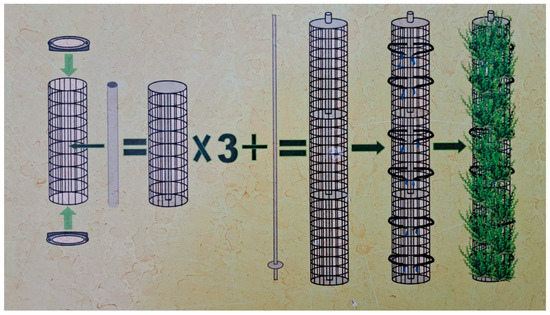
Figure 7.
The vertical column construction scheme.
4.2. Maintenance of the Columns
Plants grown in the vertical columns were not cut during their growing season. Dead plant biomass was removed annually after winter in April. The columns were watered every day. Each of the three levels of the segmental columns had separate water supply sections (12 sections in total). Water was supplied periodically, for 5 min every 3 h daily, during the vegetation period of the plants. In the late season, when the plants stopped growing, irrigation was turned off. The plants were not fertilized since the columns were installed. The plant cover on the columns was not cut during the vegetation season, and the columns were not additionally filled with compost soil.
4.3. Plant Species Composition and Vegetation Assessment
The study was conducted over a five-year period from 2017 to 2021. The plant species composition, the projection coverage, and the abundance of each species in the vertical structures were assessed in 2017 (the first year of the experiment), 2019 (the third year) and 2021 (the fifth year), once a year in the same period. The columns were randomly selected for assessment; they were the same throughout the years of the study. Nine columns (27 segments) were evaluated on the north and south expositions, 21 columns (63 segments) were evaluated on the east exposition, and 20 columns (60 segments) were evaluated on the west (Table 5) exposition. In total, 177 segments in 59 columns were monitored. The plant species composition was assessed in each segment separately on the area of the entire segment. The Braun-Blanquet scale [39] was used for the evaluation of the coverage abundance of different species. The plant communities were distinguished according to the vegetation classification systems proposed by J. Balevičienė [21], J. Balevičienė et al. [22], and W. Matuszkiewicz [23].
4.4. Analysis of Meteorological Data and Ecological Parameters
The meteorological parameters were obtained from the nearby Vilnius Automatic Meteorological Station of the Lithuanian Meteorological Service, whose coordinates are N54.625992, E25.107064. Lithuania is located in the mid-latitude climate zone and belongs to the southwestern subregion of the Atlantic continental forest area. On average, plant vegetation starts in the first decade of April and ends by the first decade of October. The monthly physical environmental parameters, the mean air temperature, and the duration of sunshine and precipitation for the study years 2017–2021 are presented in Figure 8.

Figure 8.
Dynamics of climatic environmental factors in Vilnius over the study years 2017–2021.
No particular severe winter conditions were specified; the winters in 2017–2021 were mild, and minus temperatures did not exceed the limits defined for a USDA 5b hardiness zone. The winter of 2019–2020 was exceptionally mild, with the lowest temperatures of −5–−8 °C occasionally recorded, and the mean was above zero, at 1.8°C in comparison to −2.9 °C for the long-term mean.
Heat waves were common in summer during the study years (Table 6). In 2019, the months of July and June were extremely hot: the mean temperature reached 22.4 °C in July and 19.5 °C in June (hottest since 1961). The incidences of stressful meteorological conditions, such as frosts in spring and summer heat waves, which can affect plant vegetation, are listed in Table 6.
4.5. Statistical Analysis and Calculations
One-way analysis of variance (ANOVA) was used to assess the differences in the number of species in the segments of the vertical columns between different expositions and different years. The statistical analyses were carried out using STATISTICA® 7 and MS Excel Software. The diagrams of meteorological and ecological parameters and plant community dynamics were drawn using MS Excel Software.
5. Conclusions
In summary, we make the following conclusions: (i) the vegetation cover of a semi-natural meadow turf changes significantly when it is used in artificial vertical columns, and the number of initial plant species is reduced by about a third; (ii) however, due to the establishment of a high number new species, the columns remain sufficiently covered by green plant layers for up to five years. The original plant species of the fertile soils were mostly replaced by ruderal, nitrophilous, and pioneer plants. Out of the 58 original species, 18 disappeared, while 39 new ones emerged. In the vegetation cover of the north exposition, the original species composition dwindled most rapidly, and the most active replacement with newly emerging species occurred. The five-year observations showed that the original meadow plant communities belonging to the Molinio-Arrhenatheretea elatioris vegetation class were partially replaced by the plant communities of the Koelerio-Corynephoretea canescentis and Artemisietea vulgaris vegetation classes; however, unformed plant communities finally became prevalent. The columns on all the sides of the building were equally dominated by semi-shade- and semi-light-loving plant species, together with less abundant light-loving species. The most persistent species were ruderal short-lived C. canadensis, M. albus, and U. dioica, and long-lived E. repens. In some instances, the loss of the dominant, rapidly cover-forming species led to the apparent establishment of new species. The most active newly spreading species were the annual A. arenosa and the perennial F. pratensis. Our study shows that the turfs of local semi-natural meadows are suitable for the installation of vertical columns for greening of buildings in the harsh climate of a USDA 5b hardiness zone, which is accompanied by sudden climatic fluctuations, including frosts in the early season and heat waves in the summer.
Author Contributions
Conceptualization, A.S. and I.P.; methodology, V.S. and I.P.; investigation, V.S.; software, V.S. and K.L.; formal analysis, V.S., K.L. and I.P.; writing–original draft preparation, V.S., I.P., K.L. and D.R.; writing–review and editing, V.S., I.P., and K.L.; visualization, V.S., I.P. and A.S. All authors have read and agreed to the published version of the manuscript.
Funding
The structure of the green columns system was funded: by the project under the State Investment Program “Reconstruction and development of the infrastructure of the Botanical Garden of Vilnius University in Kairėnai” 2004–2016; by the project financed under the LAAIF “Climate Change Special Program” measure—“Renovation (modernization) of public and residential buildings (for persons of various social groups), reducing energy consumption costs” “Modernization of the administrative/laboratory building of the Botanical Garden of Vilnius University with annexes, improving the balance of energy costs” (LENERG) 2015–2016. The projects were developed and implemented by A.S.
Institutional Review Board Statement
Not applicable.
Informed Consent Statement
Not applicable.
Data Availability Statement
All the data are included in the main text.
Conflicts of Interest
The authors declare no conflict of interest.
References
- Jain, R.; Janakinam, T. Vertical Gardening: A New Concept of Modern Era. In Commercial Horticulture, 3rd ed.; New India Publishing Agency: New Delhi, India, 2016; pp. 527–536. [Google Scholar]
- Ekren, E. Advantages and Risks of Vertical Gardens. Bartın Orman Fakültesi Derg. 2017, 19, 51–57. [Google Scholar]
- Meral, A.; Başaran, N.; Yalçınalp, E.; Doğan, E.; Ak, M.K.; Eroğlu, E. A Comparative Approach to Artificial and Natural Green Walls According to Ecological Sustainability. Sustainability 2018, 10, 1995. [Google Scholar] [CrossRef]
- Pérez, G.; Coma, J.; Martorell, I.; Cabeza, L.F. Vertical Greenery Systems (VGS) for energy saving in buildings: A review. Renew. Sustain. Energy Rev. 2014, 39, 139–165. [Google Scholar] [CrossRef]
- Radić, M.; Dodig, M.B.; Auer, T. Green Facades and Living Walls–A Review Establishing the Classification of Construction Types and Mapping the Benefits. Sustainability 2019, 11, 4579. [Google Scholar] [CrossRef]
- Perini, K.; Ottelé, M. Designing green façades and living wall systems for sustainable for constructions. Int. J. Des. Nat. Ecodynamics 2014, 9, 31–46. [Google Scholar] [CrossRef]
- Örnek, M.A.; Çağdaş, G. A Case Based Model For Designing Vertical Gardens. DLA Conf. 2011, 315–319. [Google Scholar]
- Timur, Ö.B.; Karaca, E. Vertical Gardens. In Advances in Landscape Architecture, 1st ed.; IntechOpen: London, UK, 2013; pp. 587–622. [Google Scholar]
- Xue, J. Redefining and Reapplication of the Vertical Garden Intersonal Household Context. Master’s Thesis, Yeates School, Toronto, ON, Canada, 2015; p. 25. [Google Scholar]
- Bașdoğan, G.; Çiğ, A. Ecological-social-economical impacts of vertical gardens in the sustainable city model. Yüzüncü Yıl Üniversitesi Tarım Bilim. Derg. 2016, 26, 430–438. [Google Scholar]
- Perini, K.; Ottelé, M.; Haas, E.M.; Raiteri, R. Greening the building envelope, facade greening and living wall systems. Open J. Ecol. 2011, 1, 1–8. [Google Scholar] [CrossRef]
- Sharma, P. Vertical Gardens—An Innovative Element of Green Building Technology. In Proceedings of the Internal Conference (GYANODAY 2015), Greater Nodia, India, 28 November 2015; Volume 42. [Google Scholar]
- Sheweka, S.; Magdy, N. The Living walls as an Approach for a Healthy Urban Environment. Energy Procedia 2011, 6, 592–599. [Google Scholar] [CrossRef]
- Lin, S.; Zhang, L. A mathematical model for vertical column farming system design of leafy vegetable crops. J. Phys. Conf. Ser. 2018, 1096, 012051. [Google Scholar] [CrossRef]
- Sasaki, T.; Lauenroth, W.K. Dominant species, rather than diversity, regulates temporal stability of plant communities. Oecologia 2011, 166, 761–768. [Google Scholar] [CrossRef]
- Surat, H.; Eminagaoglu, O. Determinaion of the aesthetical and functional use of certain natural plants in Hatila Valley national park in landscape architecture. Int. J. Ecosyst. Ecol. Sci. 2018, 8, 113–134. [Google Scholar]
- FloraWeb—Biologische Merkmale. Available online: https://www.floraweb.de/ (accessed on 12 July 2022).
- Stollberg, M.; Moser, G.; Müller, C.; Birgelen, A. Meadow-living walls: Creating attractive vertical greenery with meadow seed mixtures—Experiences and recommendations from a three year field trial. Ecol. Eng. 2022, 185, 106817. [Google Scholar] [CrossRef]
- Campiotti, C.A.; Gatti, L.; Campiotti, A.; Consorti, L.; De Rossi, P.; Bibbiani, C.; Muleo, R.; Latini, A. Vertical Greenery as Natural Tool for Improving Energy Efficiency of Buildings. Horticulturae 2022, 8, 526. [Google Scholar] [CrossRef]
- Ratyńska, H.; Lewandowska, A.; Waldon-Rudzionek, B.; Mazur, M. Species share of Molinio-Arrhenatheretea class in vegetation of the forest arboretum in Zielonka near Poznań and in Adjacent treestands. Steciana 2015, 19, 245–253. [Google Scholar] [CrossRef]
- Balevičienė, J. Syntaxonomy-Phytogeographical Structure of Vegetation in Lithuania; Mokslas: Vilnius, Lithuania, 1991. [Google Scholar]
- Balevičienė, J.; Kizienė, B.; Lazdauskaitė, Ž.; Patalauskaitė, D.; Rašomavičius, V.; Sinkevičienė, Z.; Tučienė, A.; Venckus, Z. Vegetation of Lithuania. Meadows; Šviesa: Kaunas, Lithuania, 1998. [Google Scholar]
- Matuszkiewicz, W. Przewodnik do Oznaczania Zbiorowisk Roślinnych Polski; Wydawnictwo Naukowe PWN: Warszawa, Poland, 2008. [Google Scholar]
- Laime, B.; Tjarve, D. Grey dune plant communities (Koelerio-Corynephoretea) on the Baltic coast in Latvia. Tuexenia 2009, 29, 409–435. [Google Scholar]
- Isbell, F.; Craven, D.; Connolly, J.; Loreau, M.; Schmid, B.; Beierkuhnlein, C.; Bezemer, T.M.; Bonin, C.; Bruelheide, H.; de Luca, E.; et al. Biodiversity increases the resistance of ecosystem productivity to climate extremes. Nature 2015, 526, 574–577. [Google Scholar] [CrossRef]
- Pashkevych, N. Ruderal vegetation of Skhidnytsia village-resort (Lviv region, Ukraine). Stud. Biol. 2018, 12, 63–76. [Google Scholar] [CrossRef]
- Linder, H.P.; Lehmann, C.E.R.; Archibald, S.; Osborne, C.P.; Richardson, D.M. Global grass (Poaceae) success underpinned by traits facilitating colonization, persistence and habitat transformation. Biol. Rev. 2017, 93, 1125–1144. [Google Scholar] [CrossRef]
- Mårtensson, L.-M.; Wuolo, A.; Fransson, A.-M.; Emilsson, T. Plant performance in living wall systems in the Scandinavian climate. Ecol. Eng. 2014, 71, 610–614. [Google Scholar] [CrossRef]
- Flora of Lithuania; State Publishing House of Political and Scientific Literature: Vilnius, Lithuania, 1961; Volume 3.
- Flora of Lithuania; State Publishing House of Political and Scientific Literature: Vilnius, Lithuania, 1976; Volume 5.
- Flora of Lithuania; State Publishing House of Political and Scientific Literature: Vilnius, Lithuania, 1980; Volume 6.
- Lekavičius, A. A Guide to Getting to Know Plants; Mokslas: Vilnius, Lithuania, 1989. [Google Scholar]
- Ganjurjav, H.; Gornish, E.S.; Hu, G.; Wan, Y.; Li, Y.; Danjiu, L.; Gao, Q. Temperature leads to annual changes of plant community composition in alpine grasslands on the Qinghai–Tibetan Plateau. Environ. Monit Assess 2018, 190, 585. [Google Scholar] [CrossRef] [PubMed]
- Zhang, Y.; Loreau, M.; He, N.; Wang, J.; Pan, Q.; Bai, Y.; Han, X. Climate variability decreases species richness and community stability in a temperate grassland. Oecologia 2018, 188, 183–192. [Google Scholar] [CrossRef] [PubMed]
- Jørgensen, L.; Thorup-Kristensen, K.; Dresbøll, D.B. Against the wall—Root growth and competition in four perennial winter hardy plant species grown in living walls. Urban For. Urban Green. 2018, 29, 293–302. [Google Scholar] [CrossRef]
- Benvenuti, S.; Malandrin, V.; Pardossi, A. Germination ecology of wild living walls for sustainable vertical garden in urban environment. Sci. Hortic. 2016, 203, 185–191. [Google Scholar] [CrossRef]
- Lithuanian Hydrometeorological Service. Available online: http://www.meteo.lt/en/ (accessed on 25 January 2023).
- Galvonaitė, A.; Valiukas, D.; Kilpys, J.; Kitrienė, Z.; Misiūnien, M. Climate Atlas of Lithuania; Lithuanian Hydrometeorological Service under the Ministry of Environment; Lithuanian Hydrometeorological Service: Vilnius, Lithuania, 2013. [Google Scholar]
- Braun-Blanquet, J. Pflanzensoziologie, Grundzüge der Vegetationskunde, 3rd ed.; Wien: New York, NY, USA, 1964. [Google Scholar]
Disclaimer/Publisher’s Note: The statements, opinions and data contained in all publications are solely those of the individual author(s) and contributor(s) and not of MDPI and/or the editor(s). MDPI and/or the editor(s) disclaim responsibility for any injury to people or property resulting from any ideas, methods, instructions or products referred to in the content. |
© 2023 by the authors. Licensee MDPI, Basel, Switzerland. This article is an open access article distributed under the terms and conditions of the Creative Commons Attribution (CC BY) license (https://creativecommons.org/licenses/by/4.0/).